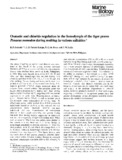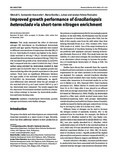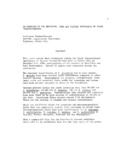| dc.contributor.author | Ludevese-Pascual, Gladys | |
| dc.contributor.author | Laranja, Joseph Leopoldo | |
| dc.contributor.author | Amar, Edgar | |
| dc.contributor.author | Bossier, Peter | |
| dc.contributor.author | De Schryver, Peter | |
| dc.date.accessioned | 2019-03-12T06:38:26Z | |
| dc.date.available | 2019-03-12T06:38:26Z | |
| dc.date.issued | 2019 | |
| dc.identifier.citation | Ludevese-Pascual, G., Laranja, J. L., Amar, E., Bossier, P., & De Schryver, P. (2019). Artificial substratum consisting of poly-β-hydroxybutyrate-based biodegradable plastic improved the survival and overall performance of postlarval tiger shrimp Penaeus monodon. Aquaculture Research, 50(4), 1269-1276. | en |
| dc.identifier.issn | 1355-557X | |
| dc.identifier.uri | http://hdl.handle.net/10862/3436 | |
| dc.description.abstract | The use of artificial substratum consisting of poly‐β‐hydroxybutyrate (PHB)‐based biodegradable plastic for penaeid shrimp culture was investigated in the present study. The survival of postlarval tiger shrimp Penaeus monodon (30 ± 5 mg) provided with PHB substratum made out of PHB type DP9002 (Metabolix GmbH, Köln, Germany) was 88.7 ± 3.4% and this was significantly higher as compared to postlarvae provided conventional substratum consisting of polyvinylchloride (PVC) pipes (67.3 ± 6.5%). However, no significant weight improvement was observed for the postlarval tiger shrimp indicating that PHB could not be used as growth promoter. Nevertheless, a trend of improved robustness against adverse environmental conditions (lethal ammonium chloride concentration) and increased resistance to pathogenic Vibrio was observed in postlarval tiger shrimp provided with PHB substratum as compared to postlarvae provided with PVC substratum. Results indicate higher preference by postlarvae on PHB substratum over PVC substratum. Overall, this study indicates the potential of artificial substratum consisting of PHB‐based biodegradable plastic as replacement for conventional substratum consisting of PVC pipes in enhancing the survival of postlarval tiger shrimp and improving its performance against adverse environmental conditions and disease resistance. | en |
| dc.description.sponsorship | This study was funded by the Flemish Interuniversity Council (VLIR). | en |
| dc.language.iso | en | en |
| dc.publisher | Wiley | en |
| dc.subject | Decapoda | en |
| dc.subject | Penaeus monodon | en |
| dc.subject | Artificial substratum | en |
| dc.subject | poly-β-hydroxybutyrate (PHB) | en |
| dc.subject | Chloride resistance | en |
| dc.subject | polyvinyl chloride | en |
| dc.subject | ammonium | en |
| dc.subject | Polyhydroxybutyrate | en |
| dc.subject | biodegradability | en |
| dc.subject | Vibrio | en |
| dc.subject | Waterborne diseases | en |
| dc.title | Artificial substratum consisting of poly-β-hydroxybutyrate-based biodegradable plastic improved the survival and overall performance of postlarval tiger shrimp Penaeus monodon | en |
| dc.type | Article | en |
| dc.citation.volume | 50 | |
| dc.citation.issue | 4 | |
| dc.citation.spage | 1269 | |
| dc.citation.epage | 1276 | |
| dc.citation.journalTitle | Aquaculture Research | en |
| dc.subject.asfa | pipes | en |
| dc.subject.asfa | biodegradation | en |
| dc.subject.asfa | disease resistance | en |
| dc.subject.asfa | ammonium compounds | en |
| dc.subject.asfa | shrimp culture | en |
| dc.subject.asfa | survival | en |
| dc.subject.asfa | environmental conditions | en |
| dc.subject.asfa | substrata | en |
| dc.subject.asfa | ammonium chloride | en |
| dc.subject.asfa | plastics | en |
| dc.subject.asfa | pathogens | en |
| dc.subject.asfa | shellfish | en |
| dc.subject.asfa | aquaculture | en |
| dc.subject.asfa | biodegradable substances | en |
| dc.subject.asfa | weight | en |
| dc.subject.asfa | growth | en |
| dc.identifier.essn | 1365-2109 | |
| dc.identifier.doi | 10.1111/are.14003 | |
| dc.subject.scientificName | Penaeus monodon | en |



